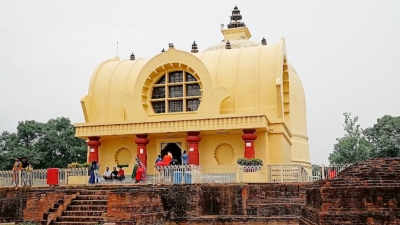New Delhi : As the inaugural flight from Sri Lanka carrying a delegation of over 100 Buddhist monks and a 12-member holy relic entourage bringing holy Buddhist relics landed at Kushinagar International Airport, Uttar Pradesh on October 20, 2021, history was made.
It was an acknowledgement of the rightful place that the city deserves in the ambitious scheme of Buddhist Circuit and in any attempt to rediscover the Buddhist legacy of the country, for the city has many tales to tell. This is an attempt to understand the significance of rediscovering and celebrating India’s Buddhist heritage, by focusing on the city of Kushinagar.
The ancient city of Kushinagar/Kushinara is believed to have been the place where Gautam Buddha attained Mahaparinirvana (nirvana after death).
The Mahayana Mahaparinirvana Sutra, which is one of the major Sutras of Mahayana Buddhism, mentions that the Buddha made his journey to Kushinagar, died and this is the place where he was cremated.
Sarnath, where Lord Buddha gave the first sermon, is within a radius of around 150 km from Kushinagar. Bodh Gaya, where Buddha attained enlightenment, and Lumbini, where Buddha was born, are also not very far away from Kushinagar. In this sense, the city is at the centre of the Buddhist Circuit.
The Buddhist Circuit is an attempt to tap the potential of developing tourism and development around Buddhist heritage by linking important sites associated with the life of Buddha. Buddhism, a religion that continues to capture the imagination of masses worldwide, is believed to have originated in the late 6th century BCE around the teachings of Mahatma Buddha or Shakya Muni.
Born as Prince Siddhartha in Lumbini in present-day Nepal, he became ‘Buddha’ or the enlightened one after he attained enlightenment at Bodh Gaya, in present day Bihar and it was at Sarnath that he delivered his first sermon.
The Buddhist Circuit follows the footsteps of Buddha from Lumbini, through Bodhgaya to Sarnath and then to Kushinagar. The Kushinagar airport will help in attracting more followers of Buddhism from home and abroad to Kushinagar, and other sites.
There are around 50 crore Buddhists across the globe, out of which, around 90 per cent of live in East and Southeast Asia. It was Mauryan Emperor Ashoka who played a key role in the spread of Buddhism across the region; he spread the message of peace and harmony by erecting stupas, pillars and rock edicts across his empire, now scattered over India, Nepal, Bangladesh, Afghanistan, Pakistan and Sri Lanka. The region, thus boasts of a shared heritage that should be nourished and developed to evolve an inclusive model of tourism.
The new airport will aid direct aviation connectivity with South Asian countries, thus making it easier for tourists arriving from Sri Lanka, Japan, Taiwan, South Korea, China, Thailand, Vietnam and Singapore to visit Kushinagara, Lumbini, Sarnath and other key places like Ujjain, Nalanda, Rajgir, Sravasti and Gaya.
Such efforts at showcasing the Buddhist heritage that India, as the land of Buddha, proudly owns are essential to counter the increasing attempts by countries like China to sinicise Buddhism.
China, officially an atheist nation, has begun to describe Buddhism as an “ancient Chinese religion” and is using Buddhism as a tool to extend its influence in other countries.
Central to this are the debates regarding the reincarnation of the 14th Dalai Lama, the religious head of Tibetan Buddhists, who is currently living in exile in India after China unlawfully occupied his homeland in 1959.
China is trying to interfere in the reincarnation process and will install their own Dalai Lama in China, just like it abducted Tibet’s Panchen Lama to install its own Panchen in China. Pakistan is also trying to project itself as a cradle of Buddhist heritage by Gandharan Buddhist heritage and is hosting Buddhist Conclaves too.
China’s Belt and Road Initiative in itself uses Buddhism as a link between the countries to establish connections. Under these circumstances, India has to be more vocal about its Buddhist connections and it remains a key pillar of its soft power.
In this context, Kushinagar airport can serve as a gateway to India’s Buddhist heritage, welcoming the world to visit and immerse in the glorious culture it has to offer.
The new airport and the related infrastructural growth will help accelerate employment opportunities and will boost income growth of the local population, thus contributing to the overall development of the place. It is important to note that the airport is going to serve a population of more than two crore, especially the largely migrant population of the region.
It will act as a major driver of growth for the country which is still to recover from the spillover effects of the COVID19 pandemic on its economy. Experts have also noted that the airport will help fortify the export of horticultural products like bananas and strawberries.
Under its schemes of ‘Swadesh Darshan’ and ‘Pilgrimage Rejuvenation and Spiritual Heritage Augmentation Drive’ (PRASHAD), the government of India has launched several initiatives to revive India as a Global Centre of Buddhist Culture and Tourism.
The plan involves developing connectivity, infrastructure, logistics, education, research and improving public awareness regarding the rich Buddhist heritage.
Kushinagar can serve as the focal point for the growth of Buddhist tourism and enhance India’s outreach to South and South East Asia.
Prime Minister Narendra Modi’s proposed visit to birthplace of Gautam Buddha (Lumbini) in Nepal on May 16 has come as a ray of hope.
–IANS


Comments are closed.